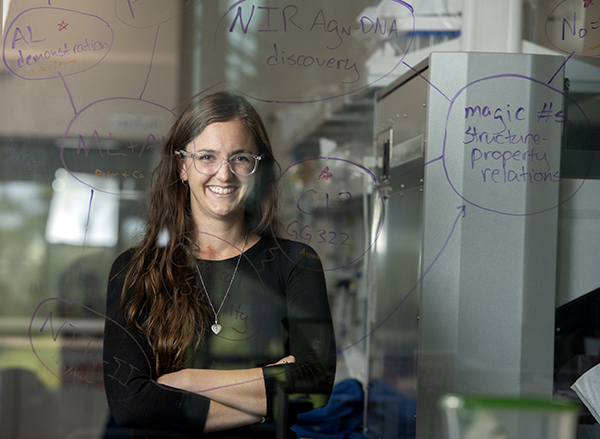Copp Lab Engineers Stronger Programmable DNA Nanostructures

Jan. 30, 2024 – A UC Irvine-led team of researchers are making exciting advances in DNA nanotechnologies. DNA’s sequence-encoded properties enable researchers to harness DNA as a custom molecular building block for engineering nanomaterials. These programmable nanomaterials platforms hold significant promise for a range of fields from bioelectronics and chemical sensing to nanorobotics and biomedicine. However, many of these materials also suffer from a lack of stability and can degrade in harsh environments.
A team led by UC Irvine’s Stacy Copp, assistant professor of materials science and engineering, recently reported a new approach to enhance the stability and functionality of DNA nanostructures while still retaining their remarkable bio-enabled properties. The research is published in the American Chemical Society journal ACS Nano.
The team addresses the major, long-term issue of thermal and chemical fragility of DNA nanomaterials by creating DNA duplexes that are paired together with silver ions. These silver-mediated DNA duplexes are far more stable than nature’s DNA duplex and can persist up to nearly the temperature of boiling water.
"This research represents an exciting new advance in DNA nanotechnologies. By simply mixing silver ions with DNA, it is possible to create structures that are far more stable than what nature affords us," said Copp.
While these kinds of duplexes are not new, the exact mechanisms of their formation were unknown. Copp Lab graduate student Eshana Bethur and postdoctoral scholar Rweetuparna Guha, together with UCI mass spectrometry expert Ben Katz, developed strategies to delicately measure the compositions of metal-mediated DNA duplexes using high-resolution mass spectrometry. They then paired the mass measurements with a sensitive optical technique called circular dichroism spectroscopy to monitor the molecular conformations of the duplexes using light. They discovered that under certain conditions, the silver-paired DNA duplexes appeared to assemble into larger nanostructures.
Next, the UCI researchers collaborated with Paul Ashby, a staff scientist of the Department of Energy-funded Molecular Foundry, a nanoscience user faculty at Lawrence Berkeley National Laboratory. Working with Ashby at the Foundry, Bethur showed that it is possible to form long wires of silver-paired DNA duplexes, which could have exciting applications for DNA-based nanoelectronics.
Armed with a clearer understanding of how to control the formation of these duplexes, the Copp Lab then worked with University of Alberta researcher Hongbo Zeng and graduate student Ziqian Zhao to measure the nanomechanical properties of the tiny duplexes. By attaching a single layer of silver-paired DNA duplexes to a gold surface and then compressing the duplexes with a mica surface, the team showed that silver-paired DNA duplexes are stiffer than nature's, confirming past predictions.
“To our knowledge, this is the first time that the nanomechanical stiffness of a metal-mediated DNA duplex has been directly measured,” explained Copp. “This stiffness is an important parameter for building nanoscale DNA materials that take advantage of the special properties of DNA-metal interactions.
"This project is also an excellent example of the importance of pursuing collaboration to tackle cross-disciplinary challenges in science and engineering,” said Copp. “Our co-authors all made major contributions to this project, and we have learned a tremendous amount from their expertise.”
Copp’s coauthors on the paper include Bethur, Guha and Katz from UCI; Ashby from the Molecular Foundry; and Zhao and Zeng from the University of Alberta. The research was funded by the Air Force Office of Scientific Research.
– Lori Brandt
